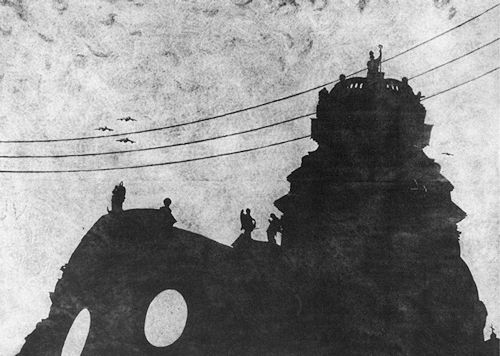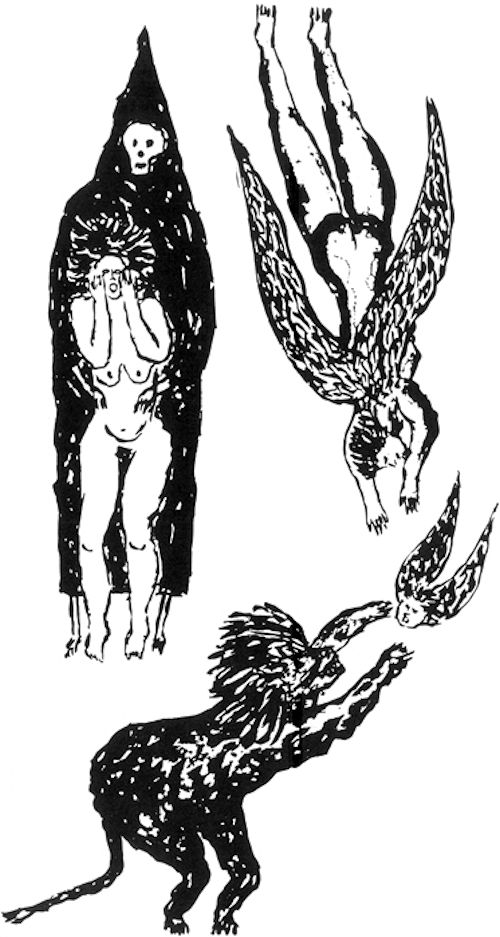Last summer I binged on popular books about the ’80s: Sidney Blumenthal’s Our Long National Daydream, Robert Reich’s The Resurgent Liberal, Barbara Ehrenreich’s The Worst Years of Our Lives, Connie Bruck’s The Predators’ Ball, Kevin Phillip’s The Politics of Rich and Poor, etc. Much of this material first appeared in magazines as the decade unfolded; now gathered between hard covers, it’s an occasion for retrospection on the Decade of Greed. Yet it may be too soon for postmortems. Mike Milken is behind bars, but junk bonds are still legal. Our “victory” in the cold war has breathed new life into economic laissez-faire. An increasingly conservative Supreme Court will likely contribute to the continuing erosion of American public life. And though the 1990 census didn’t count them, the homeless haven’t heard that the ’80s are over.
Still, even conservatives have accepted the idea that paper profits don’t stack up to gains in material production and technological skill. And what struck me as I read these books is that we’re overdue for some assessment of the paper that proliferated in the architecture world. The ’80s were a golden age of paper architecture; I wrote more often and more enthusiastically then about unbuilt projects than about built ones. Now I wonder if much of this work wasn’t the esthetic equivalent of junk bonds. It created the illusion of creative vitality at a time when architecture itself lay in a coma.
In June, I joined a panel discussion at the Architectural League of New York to mark the tenth anniversary of the league’s Young Architects’ Forum. This annual event showcases the mostly unbuilt work of architects at the outset of their careers. There was cause for celebration in the consistently high level of the work displayed. Yet I couldn’t let the occasion pass without remarking that this series coincided with one of the most disastrous decades in the architectural history of the league’s hometown. Just back from Barcelona, I was fired up from seeing what architects and city planners have accomplished there in the past ten years. I’d seen what wonders can be accomplished when architects mobilize themselves to exert the pressure of their ideas against the material world. So I was hardly the ideal audience for an event called “Practice”--the title of this year’s forum--from which all built and even potentially habitable work had been excluded. Was this supposed to be ironic? What I saw wasn’t irony, but rather the predictable progress of a professional demoralization so advanced that it has become a mark of intellectual backwardness to talk about “the real world.”
The paper plane remains a place where architects can develop ideas outside market pressures. It should be defended as such even though that plane became something of a market itself in the 1980s. After all, all those monographs of conceptual architecture, those gallery shows of drawings, can be a catalyst: a way to mobilize action, a channel through which ideas can pass on their way to realization. As stimulants to vision and emotion, paper projects are also valuable as independent objects. The problem with paper architecture in the ’80s was not that it may have drained talent away from conventional practice but that it came to resemble conventional practice.
In July, I watched a new building go up on Third Avenue, a dormitory for students at Cooper Union. It is terrible architecture: brutal in design, banal in program, insensitive to physical context and community desires, sinister in what it portends for the future of a neighborhood marked out by Cooper’s master plan for expansion. It is a disgraceful reflection on a school of architecture and on the school’s trustees, who selected this design. Their heads should be on pikes. And a special torture should be devised for John Hejduk, the school’s dean, for his role in creating a climate in which this episode could occur.
Hejduk, the guru--the Mike Milken--of paper architecture, has made a career of standing aloof from conventional practice. Though he’s done some fine building, Hejduk’s reputation is based almost entirely on drawings, theatrical “masques,” and turgid poems. The drawings are gorgeous. They trace Hejduk’s passage from an early preoccupation with Corbusian forms to the development of a highly personal cityscape hauntingly furnished with watchtowers, freighters, angels. As the poet David Shapiro has observed, the angel is Hejduk’s “Modulor”--his winged version of the human figure Le Corbusier molded into the concrete bases of his housing projects. Hejduk’s angels signify an escape from concreteness--a withdrawal into the persona of “the inhabitant who refused to participate,” for whom Hedjuk drew a house in a 1979 series of drawings.
Some future historian may well rank Hejduk as an avatar of virtual reality, a Piranesi on the cusp of cyberspace. His legacy to the present is another matter. As a counter to a time of excess, abstention is an option well worth contemplating. It has also served the pedagogical function of reminding Hejduk’s students that, despite what they read in the newspapers, architecture and real estate are not the same thing. Beyond that, his drawings illustrate the important point that architecture unfolds inside minds as well as outside bodies. But what unfolds inside my mind when I look at Hejduk’s drawings these days is an impression of the “holy boorishness” that afflicted medieval monks. Like them, Hejduk seems to feel that his desire for purity of mind overrules any sense of responsibility for the condition of the world. Or perhaps he feels that self-absorption is the only way he can meet that responsibility. The world, in his scheme, is only a dream to begin with.
Collapsing the world into a dream is a useful tactic, a trick we all learn to make the city less oppressive. Academics have special cause to master that trick, not only because they are legendarily pained by their lack of standing in the world, but because part of their job is to stake out the biggest possible territory for the mind. For this task, Hejduk is indeed a presiding angel. His work illustrates the idea that reality is just another fantasy, the master narrative of cultural oppression. That’s why Jeffrey Kipnis, an assistant professor of architecture at Ohio State University, recently called Hejduk “the most significant architect working today.”
“Rather than defend John’s work from being identified as fantasy,” Kipnis suggests in a colloquy with Shapiro, “perhaps we should give it over entirely to being identified as fantasy. Our task would then be to expose the political agendas of any criticism which seeks to suppress fantasy in the name of reality, as if fantasy were not the foundation upon which any reality was built.” Take that, reality! Yet you don’t need a course in deconstruction to unpack the agenda in that last line’s curt dismissal of reality in the name of Hejduk’s fantasies. What finer tribute could there be to academic detachment than that “the most significant architect working today” declines to build? The whole massive weight of architecture’s tradition as an instrument of social, economic, and political power is magically dematerialized, transformed by fairy dust into a form with no more substance than a footnote in a dissertation.
Reality and fantasy do constitute a dualism, but only in the 1980s would this be construed as an excuse for failing to distinguish between them. Think how much hay was made on Wall Street by the refusal to distinguish between material goods and paper speculation. When I hear Hejduk hailed by professors, I’m reminded of those full-page “Thank You, Mike” ads that Milken’s beneficiaries took out after his indictment. Sure, Carl Icahn and Ron Perelman were sitting pretty. They didn’t have to live with all that junk. And talk about privatization. “You can’t get in it,” Hejduk once told a colleague reluctant to grant his work the status of architecture. “But I can get in it.” If Hejduk were a real-estate developer, his refusal to build might hold moral significance. But for an architect in the 1980s, paper was as good a medium as concrete for building a career. From Trump Tower to Rodeo Drive, turning inward was the order of the day. Hejduk hardly bucked the trend.
I think for all the great beauty of his “angelology” John Hejduk misses the point about angels. They are not gods; their movements are not restricted to the afterlife. Like humans, they may fall. They are intermediaries between the divine and worldly realms. That middle ground is a good place for architecture to be. It’s not as though we need Hejduk, or any architect, to peer down from a tower and tell us that the city is Piranesian. We can see that well enough for ourselves. We need architects to meet the darker forces on their own ground. That meeting may sometimes take the form of resistance to conventional practice. Hejduk’s students adopted that form when they joined to protest Cooper’s new dorm. Hejduk responded by attempting to browbeat the students into silence. A cynical interpretation is that he welcomes this hideous addition to the cityscape as confirmation that the world is no place for an artist of his exquisite sensibilities. A more likely explanation is that Hejduk is artistically so stunted that he simply didn’t recognize what a golden educational opportunity the dorm project afforded: a chance for students, faculty, trustees, and the community to learn how a good building gets built.
Our stake in architecture’s conceptual dimension is a large one, but architects who abandon their stake in matter diminish the conceptual power of their own art. Whether they mold materials into conspicuous fantasy, like Antoni Gaudi, or construct a shimmering illusion of essence, like Mies van der Rohe, architects collapse the dualism between the imaginary and the real not by shrinking back from the material world but by publicly demonstrating that matter is tractable. That, I believe, accounts for the fascination architecture holds today for many artists, poets, philosophers, and others working on the immaterial end of things. Architecture is a dualistic art. It operates not only in the realm of symbol and metaphor but in the place where matter itself takes on symbolic value. That’s where architecture earns its wings.
| |

John Bowman Alliance 1989

John Hejduk The Cry 1990
| |
|

